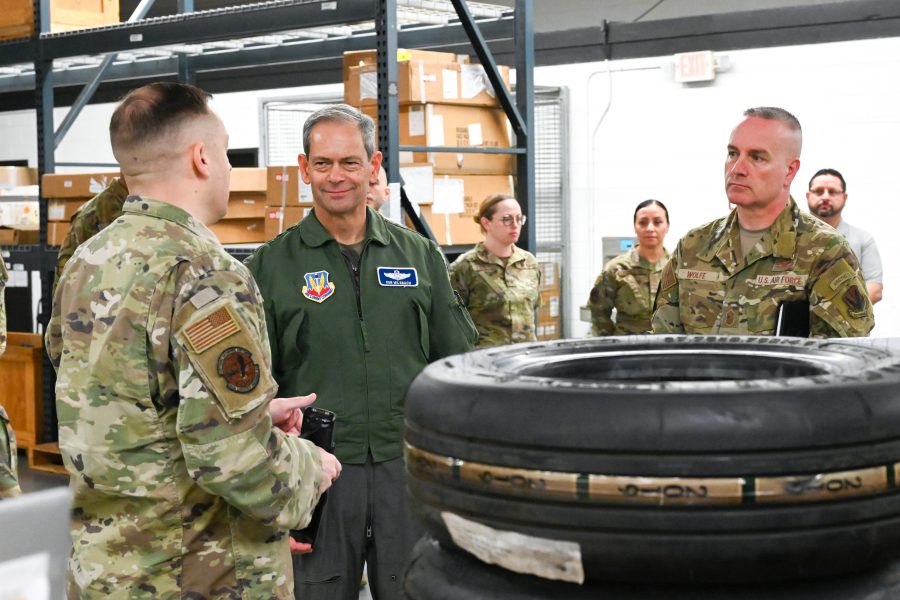Air Force pilots are not flying enough, and the service must fix what has become a chronic issue and the myriad of factors that contribute to it, particularly a lack of spare parts, the nominee to become the next Chief of Staff of the Air Force told senators during his confirmation hearing Oct. 9.
“Our pilots are flying about two to two and a half times a week in a fighter aircraft. That is not enough,” said Gen. Kenneth S. Wilsbach, who previously led Air Combat Command, which oversees a large portion of the service’s fighter jets.
Wilsbach was nominated Sept. 30 by President Donald Trump to succeed Gen. David W. Allvin, the current Chief of Staff, who is retiring early once a successor is in place.
Wilsbach attributed the lack of flying hours to a variety of factors. The Air Force’s fleet is aging and aircraft are grounded at growing rates due to maintenance issues; older aircraft are awaiting parts, and even newer aircraft, such as the F-35 Lightning II, are experiencing supply chain problems. Wilsbach pegged the Air Force’s average aircraft availability at around half the fleet. Official numbers provided by the service to Air & Space Forces Magazine earlier this year suggest that just over 67 percent of the service’s aircraft were “mission capable,” meaning the aircraft could perform at least one of its core functions at a given time in fiscal 2024—the lowest level in at least a decade.
“That means that you can’t fly your full fleet and so what that means is the pilots and the crews aren’t training,” Wilsbach said. “So we get that aircraft availability up. Now the pilots can train on a more regular basis. You don’t look at any professional sports athlete that practices two times a week—they practice almost every day.”
These days, Air Force combat pilots fly around five hours per month.
Wilsbach said while he was commander at ACC, he required fighter pilots assigned to the major command to fly at least three times per week. Air & Space Forces Magazine could not immediately confirm if Wilsbach was referring to any specific policy issued by the major command, which he led from February 2024 to August 2025 before handing the reins over to Gen. Adrian L. Spain. Before ACC, Wilsbach led Pacific Air Forces, which also controls a large fleet of aircraft.
“When I was a lieutenant, I flew almost four and a half times a week,” Wilsbach said, referring to his time as an F-15 pilot in the mid-to-late 1980s. If the Air Force were able to accomplish a number closer to that now, it would “allow the proficiency that we can develop so that we are ready,” he added. However, Wilsbach noted that today’s simulators are much more advanced than in the past, making up somewhat for lost time in the air. “That’s why I dictated three sorties a week versus more than that,” he explained.
Wilsbach cited parts availability as the main cause of the issue, stating that the service has insufficient funding for weapons system sustainment and spares—an issue Allvin has also previously raised.
“We definitely have to invest in those accounts so that the parts are on the shelves when the aircraft flies,” Wilsbach said. Speaking of the F-35, he said, the aircraft “fly for an extended number of sorties before they break the next time.”
“The problem with the F-35 is now they have to wait for the part to be shipped,” once the aircraft has an issue, he said. “Investing in those parts, so that they’re on the shelf, so the Airmen that work on the flight line can turn around to the shelf, grab the part, put it in the airplane, and now it’s going to perhaps be several more days before that jet needs to be maintained again. And that all the time where it’s sitting, waiting for that part, is downtime where we can’t use the aircraft to train. So that investment is really important to backfill the shelves with parts.”
In written answers to questions by the committee, Wilsbach again cited weapons systems sustainment and flying hour funding as an issue. He also added that the service should continue offering bonuses to retain experienced pilots, which he said would help keep instructor pilots and allow newer aviators to acclimate more quickly—known as the service’s ability to “absorb” pilots without degrading its operations. Wilsbach lauded the service’s recent reforms to pilot training that have sought to help bring on more new aviators. Still, he said the service needs more money for parts and training if it wants to be effective as it tries to boost the number of pilots.
“Without additional resources, increased pilot production will strain our pilot absorption capacity, particularly in the fighter community,” Wilsbach wrote.


